文章信息
- 王军星, 谭烨辉, 黄良民, 柯志新, 周林滨
- WANG Junxing, TAN Yehui, HUANG Liangmin, KE Zhixin, ZHOU Linbin
- 冬季南海南部微微型浮游植物分布及其影响因素
- Wintertime picophytoplankton distribution and its driving factors in the southern South China Sea
- 生态学报, 2016, 36(6): 1698-1710
- Acta Ecologica Sinica, 2016, 36(6): 1698-1710
- http://dx.doi.org/10.5846/stxb201408261697
-
文章历史
- 收稿日期: 2014-08-26
- 网络出版日期: 2015-07-29
2. 中国科学院大学, 北京 100049
2. University of Chinese Academy of Sciences, Beijing 100049, China
微微型光合浮游生物是浮游植物群落中已知最小的组成部分(0.2—3μm),包括原绿球藻、聚球藻和微微型真核3个生态类群[1]。微微型自养浮游生物分布极其广泛,从大洋到沿岸海区、贫营养海域到富营养水域、极地海域到赤道海域都有研究表明其存在[2, 3, 4, 5],它们几乎存在于所有海洋生态系统中,在生物地球化学循环和能量代谢中起着重要作用[3]。尽管微微型藻类细胞微小,个体生物量不高,但它们具有更小的营养吸收半饱和常数、更高的生产效率[6],因此在浮游植物生物量[7, 8, 9]和初级生产力[10, 11, 12]中占绝对优势,尤其在寡营养热带水域,可占初级生产力的80%以上[13]。
微微型光合浮游生物在海洋生态系统中的作用越来越受到研究者的重视。我国微微型光合浮游生物研究虽然起步较晚,但已经在近岸、河口、海峡沿岸开展了包括分布、丰度、季节变化、形成机制等的大量调查和研究[14, 15, 16],为进一步研究奠定了坚实基础。对于南海微微型光合生物的研究已经做了大量的工作,但这些研究大都集中在南海北部[16, 17, 18, 19]、粤西[20]、中国台湾海峡[21]等近岸海域,这些海区受到人为活动影响较大,而在南海南部较少受到人类活动的干扰,基础调查比较少;尤其是对于纵跨深海盆地、南沙群岛以及大陆架海区的研究更是稀少,再加上冬季海况恶劣,基础调查研究就更少。比如,Yang和Jiao[22]利用流式细胞仪首次对南海南沙群岛区域的微微型光合生物的动态进行调查研究,并分析和探讨其形成机制。Agawin等[23]对南海菲律宾沿岸海域的微微型光合生物类群中聚球藻丰度等进行调查。这些研究都是在20世纪90年代进行的,有关微微型丰度分布的调查资料亟待更新。
南海是半封闭的深海盆地,气候变化受东亚季风控制[24]。同时,南海也易受台风和潜波影响。南海南部海区气候变化比较复杂,洋流对理化性质影响较剧烈,从而对微微型生物的纬度分布和垂直分布的影响也会比较大,并且由于冬季东北季风对南海南部水体的扰动作用,影响水柱的稳定性和不同时空垂直混合强度。这也反过来会使营养盐从深层到表层以及生物过程的变化[25]。所以,营养盐的水平与其他季节有较大差别,冬季的初级生产力往往大于其他季节,那么南海南部微微型光合生物的分布以及相关环境因子是什么,为此,进行了调查以期对以后研究奠定基础。
1 材料和研究方法 1.1 研究海区和采样站位研究海区位于南海南部北纬5—13°N之间,东经110—118°E,周围加里曼丹岛,东边是巴拉望岛,南部巽他陆架,西北部是西南沙水槽,北部是南海深海盆地,暗礁和浅滩星罗棋布,具有旺盛的生产力[26]。2011年11月28日—2012年1月12日,“实验3”科考船对整个南海进行调查。设置4个断面即18°N、10°N、6°N和113°E共75个站位,但由于遭遇强台风,本航次调查了31个站位(图 1),本研究重点对113°E断面14个站位进行分析(图 1中红色标注的站位),其中,这14个站位温盐数据是完整的,但是由于采样时海况恶劣,kj31、kj33、kj36和kj38共4个站位的营养盐,Chl a和微微型没有采集水样。每个站位采集7个水层(0,25,50,75,100,150,200m)。温盐通过CTD (SBE-911 plus,USA)获取,其上有12个采水灌可用来采集所需水层的样品,并按照以下方法测定Chl a、营养盐和微微型光合生物。
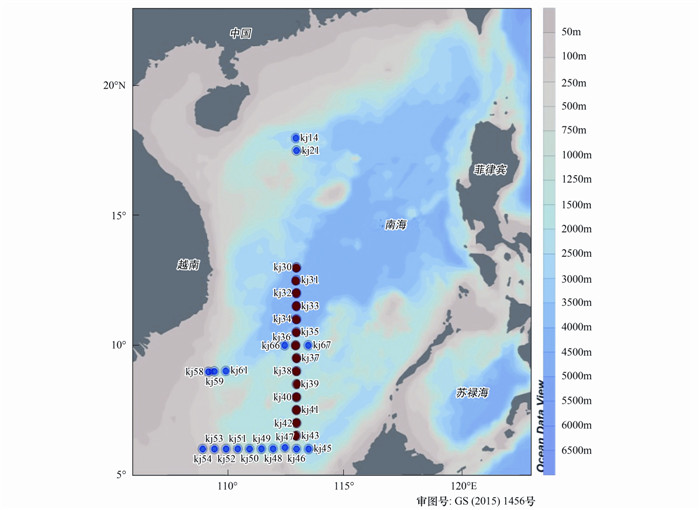
|
| 图1 2011年冬季南海南部海域调查站位 Fig.1 Study area and sampling stations in the southern SCS in winter of 2011 |
海水经过预过滤后将800mL海水用真空泵过滤到WhatmanGF/F滤膜(Whatman,Inc.,Florham Park,NJ,USA;0.7μm,Φ25 mm),然后用锡箔纸包好放入-20℃冷冻保存,航次结束回到实验室立即进行测试。Chl a浓度的测定采用荧光分析仪(Turner Designs 10-AUfluorometer),测定之前先用90%丙酮在黑暗环境中24h以完全提取,测定方法详见[27]。
1.2.2 营养盐测定在采集营养盐样品时,先用滤膜预过滤,然后将滤液装入80mL聚碳酸酯瓶中,立即冷冻保存于-20℃条件下,航次结束回到实验室立即进行分析测试。测定时先将冷冻样品解冻,利用营养盐自动分析仪来(Quickchem 8500,Lachat Instruments,USA)测定硝酸盐、磷酸盐、硅酸盐浓度,其检测限分别是0.014、0.005和0.075μmol/L,具体方法见文献[28]。
1.2.3 微微型光合生物丰度测定微微型光合生物海水样品先用20μm滤膜预过滤后装入2mL冷冻管,加入约50μL过滤的多聚甲醛混匀,在室温下放置8—10min,然后用锡箔纸包好贴上标签,放入-80℃液氮中速冻保存,带回实验室立即用流式细胞仪计数。
微微型光合生物细胞计数利用流式细胞仪(BD FACScalibur,488nm)进行分析,取0.5mL样品加入内标1μmYG荧光小球(Polysciences Co.,USA),混匀。测定时,将深度冰冻的水样放在冰水浴中缓慢融化后,注入事先测过仪器流速的流式细胞测定仪,样品以中等速度运行。细胞丰度用加入已知浓度的标准荧光小球来计算。根据FL2(橘色荧光)对FL3(红色荧光)以及侧向散射光(SSC)对FL3(红色荧光)的特征来区分这三类微微光合类群。通过CellQuest软件(BDCo.)收集保存分析数据[29]。
1.3 数据处理微微型浮游植物丰度与环境因子的相关性分析采用Pearson相关性系数相关,所有数据的统计分析在SPSS 18. 0软件上进行。
2 结果与分析 2.1 冬季温度和盐度跃层由南向北逐渐变浅研究海区受到东北季风的影响,温度和盐度跃层在25—100m水深之间剧烈变化(图 2),在整个断面上温盐跃层由南到北(7—13°N)呈现逐渐变浅的纬度分布。
由图 2温度剖面分布来看,表层25m基本在27.5℃以上,25—100m之间温度迅速降低(温跃层),直至100 m温度降到20℃,这与前人研究结果相吻合[30]。在9—11°N之间(站位kj34—38之间),等温线有明显向上位移,此海区站位水温明显比周围水体要低,比如在表层5m,站位kj36(27.47℃)比周围站位kj34(28.44℃)要低1℃,在真光层底部200m要低将近2℃(前者14.23℃,后者15.98℃);与此同时,在11—13°N之间(即kj30—34),在100m以上,等温线向上位移,在100m以下等温线向下位移,也就是说,该区域站位上层水温比周围要低,而下层比周围要高。以该区域kj32站位表层5m为例,温度为27.37℃,而周围水体温度为28.44℃(kj34),同时在真光层底部200m,kj32站位温度17.02℃,而周围水体温度为15.98℃(kj34)。以上两个区域等温线位移的变化特征,前者很有可能表明采样期间该区域存在中尺度冷涡(见讨论部分),涡内上升流使底层海水上涌到表层,导致水温比周围要低;而后者等温线变化特征则与McGillicuddy等描述的模式水涡相吻合[31],并指出模式水涡是由主密度跃层加深和季节性密度跃层变浅而形成一个厚的棱镜形状的等密度层。
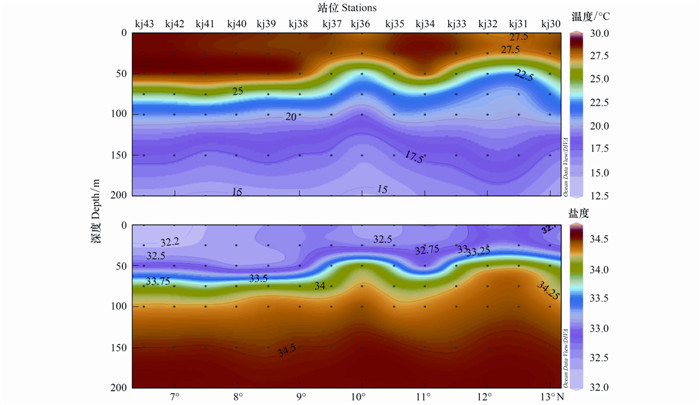
|
| 图2 冬季南海南部113°E断面站位温度和盐度垂直分布 Fig.2 Vertical profiles of temperature and salinity along the transect 113°E in the southern SCS in winter |
由图 2可知,盐度分布基本与温度一致,即在9—11°N之间以及11—13°N之间等盐度线向上位移,不同的是,在11—13°N区域内,以100m水层为界限,并没有出现主密度跃层和季节性密度跃层分离的现象,而是一致向上位移。
2.2 营养盐分布图 3显示,硝酸盐、磷酸盐和硅酸盐表层浓度较低,温跃层营养盐含量明显增大,硝酸盐跃层在75m层迅速增加到2.5μmol/L。同样,在75 m层磷酸盐和硅酸盐含量增加大约增加了2倍。9—11°N之间(图 3),在100—200m水层硝酸盐浓度(12.5—15μmol/L)要比周围水体浓度(7.5μmol/L)要高,这可能由于涡旋引起底层水体上涌带来营养盐引起;同样,在11—13°N之间的100m水层以上,硝酸盐浓度要明显高于周围水体(前者是7.5—10,后者是5.0—7.5μmol/L),而在100m水层以下,硝酸盐浓度要低于周围水体(前者7.5—10μmol/L,后者10—15μmol/L)。磷酸盐和硅酸盐在9—11°N之间以及11—13°N两个区域的浓度分布与硝酸盐分布类似,也与温盐垂直分布相吻合(图 3)。
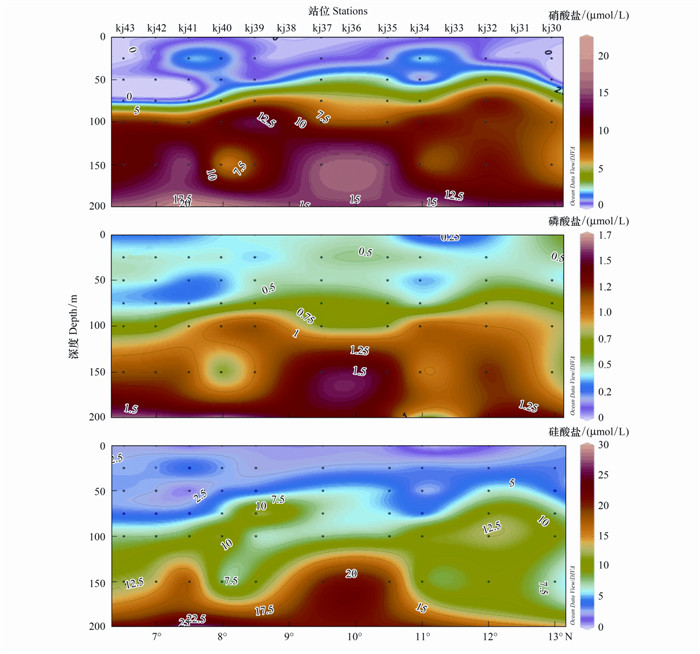
|
| 图3 冬季南海南部113 °E断面站位硝酸盐磷酸盐和硅酸盐垂直分布 Fig.3 Vertical profiles of nitrate,phosphate and silicate along the transect 113°E in the southern SCS in winter kj31、kj33、kj36和kj38四个站位营养盐数据缺失 |
由图 4和表 1所示,在9—11°N之间,水柱Chl a浓度比周围水体低。研究区域所有站位原绿球藻水柱丰度均值最大,微微型真核生物最小。聚球藻最大值为岛礁区的kj39,最小值为深海区的kj34和kj35;原绿球藻最大值站位深海站kj34,而微微型真核生物却是最小值,原绿球藻最小值出现在站位kj42和kj43,微微型真核生物最大值为kj32,最小值为kj34和kj35,与聚球藻最小值站位相同(图 4b和d)。以上结果表明,原绿球藻在寡营养盐的深海盆地区丰度分布较高,在近岸或岛礁浅水站位较低,聚球藻和微微型真核则正好相反,这些结果与Ning等调查结果是一致的[32]。
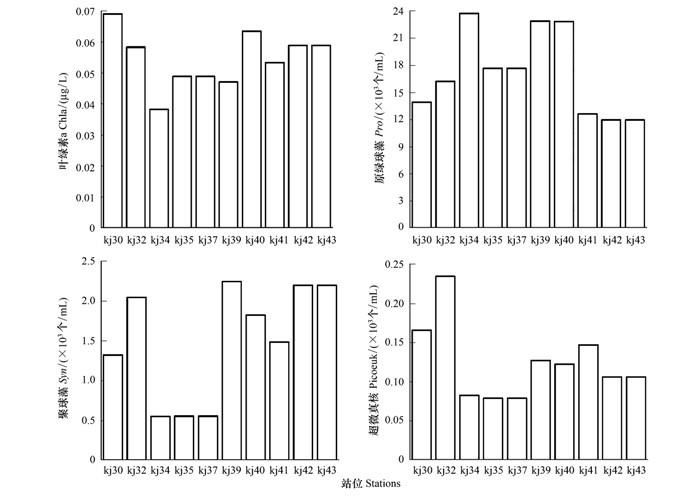
|
| 图4 冬季南海南部113°E断面站位水柱 (0—200m) Chl a浓度和微微型浮游植物丰度 Fig.4 The depth-integrated Chl a content and picophytoplankton abundances along the transect 113°E in the southern SCS |
| 站位 Sta. | 叶绿素a Chla/ (μg/L) | 聚球藻 Syn/ (×103个/mL) | 原绿球藻 Pro/ (×103个/mL) | 微微型真核 Picoeuk/ (×103个/mL) | 原绿球藻/聚球藻 Pro/Syn |
| kj30 | 0.0692 | 1.32 | 13.95 | 0.17 | 10.54 |
| kj31 | - | - | - | - | - |
| kj32 | 0.0584 | 2.05 | 16.25 | 0.23 | 7.95 |
| kj33 | - | - | - | - | - |
| kj34 | 0.0383 | 0.55 | 23.77 | 0.08 | 43.20 |
| kj35 | 0.0490 | 0.55 | 17.71 | 0.08 | 31.98 |
| kj36 | - | - | - | - | - |
| kj37 | 0.0490 | 0.55 | 17.71 | 0.08 | 31.98 |
| kj38 | - | - | - | - | - |
| kj39 | 0.0471 | 2.25 | 22.93 | 0.13 | 10.19 |
| kj40 | 0.0636 | 1.83 | 22.86 | 0.12 | 12.52 |
| kj41 | 0.0535 | 1.49 | 12.63 | 0.15 | 8.49 |
| kj42 | 0.0590 | 2.2 | 11.96 | 0.11 | 5.44 |
| kj43 | 0.0590 | 2.2 | 11.96 | 0.11 | 5.44 |
| 均值±标准误 Mean ± sd | 0.054±0.009 | 1.50±0.72 | 17.13±4.66 | 0.13±0.05 | 16.77±13.60 |
| 水柱丰度的计算公式见参考文献[35]; kj31、kj33、kj36和kj38四站位Chl a和微微型数据缺失 | |||||
图 5所示,Chl a主要分布在上层100m,表层含量较低(<0.05μg/L),25—75m存在一个次表层最大值(高达0.22μg/L,站位kj30),这与以前的研究相吻合[33]。同样,受到涡旋的影响,次表层Chl a最大值在9—11°N之间上移到表层25m,并且最大值(0.12—0.15μg/L)比周围水体(0.15—0.22μg/L)要低,这与温盐分布特征一致。由营养盐分布可知,涡旋上升流使营养盐从真光层底部上涌到上层促进了浮游植物的生长,从而使得该区域Chl a含量比周围站位要高,但又由于这些站位位于热带地区,光照和温度成为浮游植物生长的主要限制因子,因此最大值又小于周围水体[34]。同时,Chl a的分布在11—13°N区域同样受到水体扰动(涡旋)的影响。
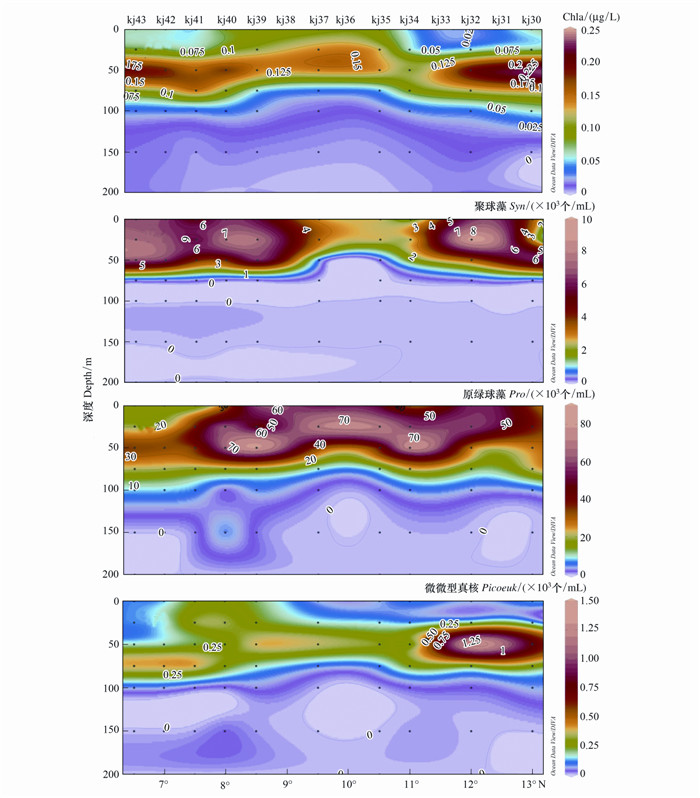
|
| 图5 冬季南海南部113 °E断面Chl a、聚球藻、原绿球藻及微微型真核垂直分布 Fig.5 Vertical profiles of Chla,Syn,Pro,and Picoeuk along the transect 113 °E in the southern SCS in winter |
微微型生物分布如图 5所示。由图 5可知,聚球藻主要分布在上层75 m,50—75 m水层其丰度急剧下降,这正好与硝酸盐跃层吻合(图 3)。在9—11 °N上涌区,聚球藻最大值层向上位移且向北偏移,且其最大值相对于周围水体明显降低,尤其是深海盆地区域(kj34和kj35,低至2×103个/mL),同样,这两个站位水柱丰度相较周围站位要低(图 4)。在9—11 °N之间,聚球藻分布大致遵循营养盐跃层变化,但在11—13 °N深海区域则不然。
图 5显示,原绿球藻主要分布在上层100 m,丰度范围为1—7×104个/mL,较聚球藻和微微型真核分别大1和2个数量级。原绿球藻与聚球藻相似,在9—11 °N上涌区,最大值层向上位移且其最大值相对于周围水体明显降低(比如,kj35站位,在50 m为5×104个/mL,kj39站位为7×104个/mL),这与kj35站位水柱丰度相较于周围站位要低是吻合的(图 4和表 1)。在11—13 °N区域,100 m等深线以上,原绿球藻丰度要高于周围站位,而100 m以下则低于周围水体,这与该区域等温线的变化较为一致,说明温度很有可能影响原绿球藻垂直分布。
图 5显示,微微型真核生物主要分布在上层100 m,次表层的最大值层(25—75 m)在11—13 °N之间更为明显(高达1.25×103个/mL),100 m 以下就迅速降低(<0.10×103个/mL)。值得思考的是,微微型真核生物次表层最大值层与Chl a次表层最大值层(25—75 m)完全吻合(图 5)。
3 讨论 3.1 原绿球藻在南海南部微微型浮游植物类群中的优势原绿球藻与聚球藻细胞丰度之比经常作为海洋营养状况和微微型生物中原绿球藻相对重要性的指标,寡营养海域的典型比值范围50—200[36],而本研究海域绿球藻与聚球藻丰度之比在5.44—43.20之间,均值为16.77,小于50(表 1),这一结果与Yang等[22]对南沙海区研究结果基本一致(12—55.24),表明采样期间该研究海域营养盐并不缺乏,分析原因一方面是冬季南海水层混合加强使底层营养盐上涌[37],另一方面可能出现了偶发现象(比如中尺度涡旋)促使局部海域营养盐增加所致(关于这一点,讨论3.3有进一步分析)
原绿球藻在微微型类群中的优势,也可以用原绿球藻碳生物量百分比来表示。通用的聚球藻、微微型真核、原绿球藻的碳生物量转换因子分别为250、2100、53fg C/个[3, 38, 39]。
图 6显示,原绿球藻碳生物量所占比例均值为50%以上,最低站位为岛礁区kj42和kj43,而深海盆地站位kj34和kj35高达70%以上。聚球藻所占比例次之,且与原绿球藻刚好相反(kj42和kj43最大,kj34最小);微微型真核所占比例最小(最大值<26.41%,kj32站位)。这些结果表明不同深度海域微微型类群分布是不同的,原绿球藻更适应寡营养环境,尽管原绿球藻细胞体积在三类微微型群落中最小,但其代表的碳生物量占了50%以上,前人有关该海域的研究碳生物量也达到了60%[22],而在岛礁区站位聚球藻所占比例逐渐替代原绿球藻的优势地位,这也与前人在雷州半岛和海南岛附近海域的研究一致,不同海域微微型浮游植物碳生物量的比较见表 2。本研究中,当把研究区域全部站位都计算在内后,聚球藻碳生物量要比原绿球藻略高,这不同与Yang等[22]在南沙群岛海域原绿球藻占优势的结果,分析原因可能是本研究中虽然研究站位包括深海、岛礁或是陆架区,但大部分还是岛礁和陆架区,而后者大多站位处于南海中部盆地等深海站位。当只计算113 °E断面时,原绿球藻就处于明显的优势地位。总的来讲,原绿球藻和聚球藻不同的生态习性,使得它们适应不同的水文条件,从而在南海不同海域占据着重要的生态地位,从而使微微型浮游植物在初级生产力组成和微型食物网中发挥着举足轻重的作用。
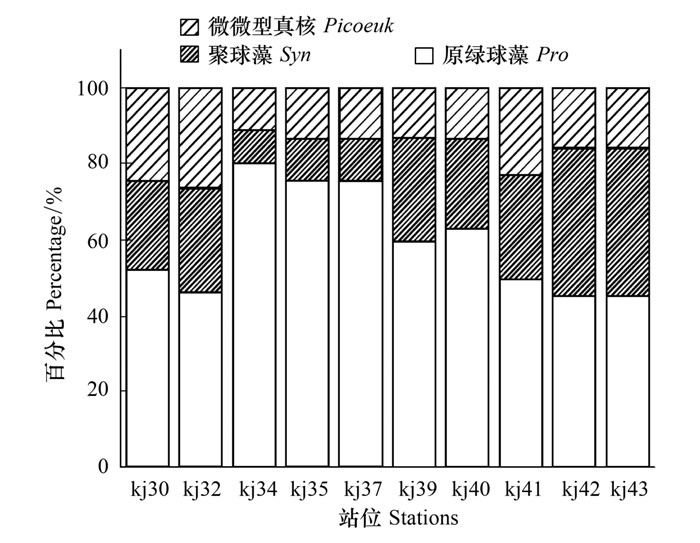
|
| 图6 冬季南海南部113°E断面站位微微型类群生物量碳占总碳的比例 Fig.6 The percentages of carbon biomass for picophytoplankton along the transect 113°E in the southern SCS in winter |
| 研究海域 Study area | 采样日期 Sampling date | 聚球藻 Syn (×103个/mL) | 原绿球藻 Pro (×104个/mL) | 微型真核 Picoeuk (×103个/mL) | |
| 南海北部 Northern SCS | 1999年8月 (n=22) | 50±76 (74%) | 4.6±4.2 (16%) | 1.8±1.1 (10%) | |
| 南沙群岛 (5—12°N, 110—118°E) | 1997年11月 (n=34) | 1.6 (8%) | 5.4 (60%) | 0.7 (32%) | |
| 南海南部 (本研究) (5—13°N, 110—118°E) | 2011年12月 整个海域 (n=27) 113 °E断面 (n=14) | 3.63±2.18 (41%) 1.50±0.72 (24%) | 1.42±0.63 (34%) 1.71±0.47 (58%) | 0.27±0.16 (25%) 0.13±0.05 (18%) | |
| 括号内为碳生物量贡献百分数 | |||||
影响微微型光合生物分布的因素很多,包括生物学因素(如生长率、捕食、病毒致死和遗传变异等)和物理化学条件(如水柱稳定性、光照、温度、微量元素以及大量元素等)[40]。
同时也会因采样时间、海域不同而有所差异,甚至有的结果不一致。Partensky等[40]研究发现在赤道太平洋区域原绿球藻与磷酸盐和硝酸盐浓度都呈负相关,而聚球藻与硝酸盐/亚硝酸盐成正相关。
本研究中微微型光合类群和环境因子的相关性分析表明,聚球藻丰度分布与温度呈极显著正相关(P<0.01),与盐度呈极显著负相关,而与营养盐关系不明显,说明在南沙海域,聚球藻与水文条件关系密切,而营养盐并不是聚球藻丰度分布的限制因子;微微型真核与硝酸盐和磷酸盐呈显著负相关,而与温盐关系不明显(表 3)。
| 相关系数 Coefficient | 温度 Temperature | 盐度 Salinity | 硝酸盐 Nitrate | 磷酸盐 Phosphate | 硅酸盐 Silicate |
| 聚球藻Syn | 0.528* * | -0.556* * | 0.096 | 0.073 | 0.19 |
| 原绿球藻Pro | -0.002 | 0.05 | -0.184 | 0.01 | -0.192 |
| 微微型真核Picoeuk | 0.386 | -0.25 | -0.419* | -0.491* | -0.255 |
| * *指在0 .01 水平(双侧)上显著相关;*在 0.05 水平(双侧)上显著相关 | |||||
中尺度涡通过剧烈的营养盐上涌、浮游植物消减和水平搅动等方式在海洋动力学、热量转运和生物地球化学收支中起着重要作用[41, 42]。
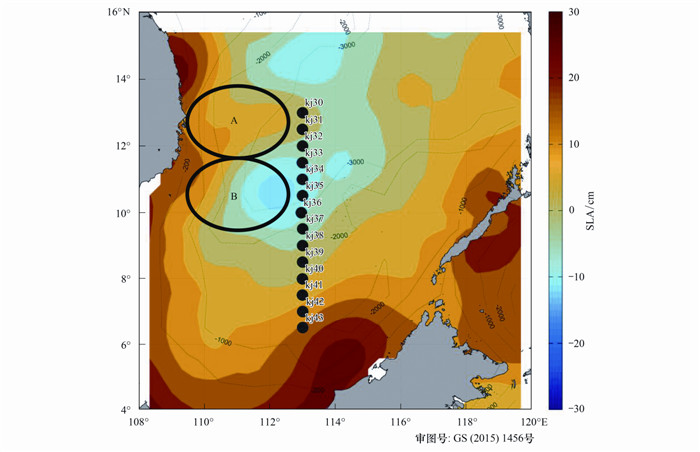
|
| 图7 冬季南海南部113°E断面采样期间经过的暖涡 (A) 和冷涡 (B) Fig.7 Warm eddy (A) and cold eddy (B) crossing the transect 113°E in winter during the sampling |
如2.3所述,深海站位kj34和kj35出现了聚球藻和微微型真核生物水柱丰度最小值(表 1和图 4),且在垂直分布上比临近站位明显较低(图 5),可能由于采样期间冷涡的存在(图 7)导致的。尽管已有大量研究表明中尺度冷涡产生的上升流能将底层营养盐输送到真光层内部从而有利于浮游植物生长[43, 44, 45],但结果表明,聚球藻丰度与营养盐无明显关系而是与温度呈显著正相关,因此,由于中尺度冷涡水体温度较周围水体要低(图 3),不利于聚球藻和微微型真核生物生长,所出现该区域站位丰度最小值现象。 kj39站位出现聚球藻水柱丰度最大值(表 1和图 5),可能由于kj39位于冷涡边缘,营养盐涌升,而温度较周围水体要高,这些都利于聚球藻生长关系密切。然而,在聚球藻和微微型真核生物丰度最小值的kj34和kj35站位,原绿球藻丰度出现最大值,分析原因可能是由于研究站位所处海区并不是典型的寡营养区(如3.1所述),同时营养盐如硝酸盐、磷酸盐、硅酸盐并不是原绿球藻的限制因子(表 3),所以物理搬运有可能形成原绿球藻在采样期间的高丰度[46]。在11—13°N区域,站位kj32出现微微型真核生物水柱丰度最大值(表 1和图 4),采样期间这两个站位位于模式水涡区(图 7),表层温度相对于周围水体要低,并且纬度上处于113°E断面的最北端,温度相对较低,表层100m水体向上涌,营养盐相对较高。
4 结论(1)研究海区营养盐浓度和Chl a含量与温盐垂直分布关系密切,尤其是在9—11°N之间,可能是由采样期间该海区存在中尺度冷涡上升流引起的营养盐上涌导致。
(2)研究海区原绿球藻细胞丰度远大于聚球藻和微微型真核生物(数量级依次为×104、×103个/mL和×102个/mL),并且原绿球藻碳生物量在深海寡营养深海站位中处于绝对优势,占总碳生物量的59%,而在整个研究海域中,原绿球藻(34%)与略低于聚球藻(41%),二者表现出明显的区域分布特征。
(3)研究海区聚球藻分布与温盐关系密切,微微型真核分布与硝酸盐和磷酸盐呈显著负相关,而原绿球藻分布可能主要受到冷涡上升流搬运作用。
(4)深海盆地区原绿球藻丰度最高的站位,聚球藻呈现最低,反之亦然,表明原绿球藻和聚球藻在生态位上具有互补性,这与原绿球藻和聚球藻分子生态学相互印证。
| [1] | Stockner J G, Antia N J. Algal picoplankton from marine and freshwater ecosystems: a multidisciplinary perspective. Canadian Journal of Fisheries and Aquatic Sciences, 1986, 43(12): 2472-2503. |
| [2] | Murphy L S, Haugen E M. The distribution and abundance of phototrophic ultraplankton in the North Atlantic. Limnology and Oceanography, 1985, 30(1): 47-58. |
| [3] | Campbell L, Nolla H, Vaulot D. The importance of Prochlorococcus to community structure in the central North Pacific Ocean. Limnology and Oceanography, 1994, 39(4): 954-961. |
| [4] | Brown S L, Landry M R, Barber R T, Campbell L, Garrison D L, Gowing M M. Picophytoplankton dynamics and production in the Arabian Sea during the 1995 Southwest Monsoon. Deep Sea Research Part II: Topical Studies in Oceanography, 1999, 46(8/9): 1745-1768. |
| [5] | Blanchot J, Rodier M. Picophytoplankton abundance and biomass in the western tropical Pacific Ocean during the 1992 El Niño year: results from flow cytometry. Deep Sea Research Part I: Oceanographic Research Papers, 1996, 43(6): 877-895. |
| [6] | Veldhuis M J W, Timmermans K R, Croot P, van der Wagt B. Picophytoplankton; a comparative study of their biochemical composition and photosynthetic properties. Journal of Sea Research, 2005, 53(1/2): 7-24. |
| [7] | Partensky F, Blanchot J, Lantoine F, Neveux J, Marie D. Vertical structure of picophytoplankton at different trophic sites of the tropical northeastern Atlantic Ocean. Deep Sea Research Part I: Oceanographic Research Papers, 1996, 43(8): 1191-1213. |
| [8] | Landry M R, Kirshtein J, Constantinou J. Abundances and distributions of picoplankton populations in the central equatorial Pacific from 12°N to 12°S, 140°W. Deep Sea Research Part II: Topical Studies in Oceanography, 1996, 43(4/6): 871-890. |
| [9] | Binder B J, Chisholm S W, Olson R J, Frankel S L, Worden A Z. Dynamics of picophytoplankton, ultraphytoplankton and bacteria in the central equatorial Pacific. Deep Sea Research Part II: Topical Studies in Oceanography, 1996, 43(4/6): 907-931. |
| [10] | Liu H, Nolla H A, Campbell L. Prochlorococcus growth rate and contribution to primary production in the equatorial and subtropical North Pacific Ocean. Aquatic Microbial Ecology, 1997, 12(1): 39-47. |
| [11] | Bell T, Kalff J. The contribution of picophytoplankton in marine and freshwater systems of different trophic status and depth. Limnology and Oceanography, 2001, 46(5): 1243-1248. |
| [12] | DuRand M D, Olson R J, Chisholm S W. Phytoplankton population dynamics at the Bermuda Atlantic Time-series station in the Sargasso Sea. Deep Sea Research Part II: Topical Studies in Oceanography, 2001, 48(8/9): 1983-2003. |
| [13] | Zubkov M V, Fuchs B M, Tarran G A, Burkill P H, Amann R. High rate of uptake of organic nitrogen compounds by Prochlorococcus cyanobacteria as a key to their dominance in oligotrophic oceanic waters. Applied and Environmental Microbiology, 2003, 69(2): 1299-1304. |
| [14] | Chiang K P, Kuo M C, Chang J, Wang R H, Gong G C. Spatial and temporal variation of the Synechococcus population in the East China Sea and its contribution to phytoplankton biomass. Continental Shelf Research, 2002, 22(1): 3-13. |
| [15] | Huang B Q, Hong H S, Lin X J, Chen J X, Liu Y. Ecological study on picophytoplankton in the Taiwan Strait.Ⅰ. Spatial and temporal distribution and its controlling factors. Acta Oceanologica Sinica, 2003, 25(4): 73-82. |
| [16] | Ning X R, Li W K W, Cai Y M, Liu C G, Shi J X. Standing stock and community structure of photosynthetic picoplankton in the northern South China Sea. Acta Oceanologica Sinica, 2005, 24(2): 57-76. |
| [17] | Ning X R, Li W K W, Cai Y M, Shi J X. Comparative analysis of bacterioplankton and phytoplankton in three ecological provinces of the northern South China Sea. Marine Ecology Progress Series, 2005, 293: 17-28. |
| [18] | 蔡昱明, 宁修仁, 刘诚刚. 南海北部海域Synechococcus和Prochlorococcus生长率和被摄食消亡率——变化范围及其与环境因子的关系. 生态学报, 2006, 26(7): 2237-2246. |
| [19] | Liu H B, Chang J, Tseng C M, Wen L S, Liu K K. Seasonal variability of picoplankton in the Northern South China Sea at the SEATS station. Deep Sea Research Part II: Topical Studies in Oceanography, 2007, 54(14/15): 1602-1616. |
| [20] | 钟瑜, 黄良民, 黄小平, 邱大俊, 宋星宇, 刘华雪. 冬夏季雷州半岛附近海域微微型光合浮游生物的类群变化及环境影响. 生态学报, 2009, 29(6): 3000-3008. |
| [21] | 黄邦钦, 洪华生, 林学举, 欧林坚. 台湾海峡微微型浮游植物的生态研究II. 类群组成、生长速率及其影响因子. 海洋学报, 2003, 25(6): 99-105. |
| [22] | Yang Y H, Jiao N Z. Dynamics of picoplankton in the Nansha Islands area of the South China Sea. Acta Oceanologica Sinica, 2004, 23(3): 493-504. |
| [23] | Agawin N S R, Duarte C M, Agustí S, McManus L. Abundance, biomass and growth rates of Synechococcus sp. in a tropical coastal ecosystem (Philippines, South China Sea). Estuarine, Coastal and Shelf Science, 2003, 56(3/4): 493-502. |
| [24] | Takahashi M, Hori T. Abundance of picophytoplankton in the subsurface chlorophyll maximum layer in subtropical and tropical waters. Marine Biology, 1984, 79(2): 177-186. |
| [25] | Fang W D, Fang G D, Shi P, Huang Q Z, Xie Q. Seasonal structures of upper layer circulation in the southern South China Sea from in situ observations. Journal of Geophysical Research, 2002, 107(C11): 23-1-23-12. |
| [26] | 蔡树群, 龙小敏, 陈荣裕, 王盛安, 黄企洲. 春季南沙群岛海区环流结构的探讨. 热带海洋学报, 2004, 23(2): 37-44. |
| [27] | Parsons T R, Maita Y, Lalli C M. A Manual of Chemical and Biological Methods for Seawater Analysis. Toronto: Pergamon Press, 1984. |
| [28] | Kirkwood D S, Aminot A, Carlberg S R. The 1994 quasimeme laboratory performance study: Nutrients in seawater and standard solutions. Marine Pollution Bulletin, 1996, 32(8/9): 640-645. |
| [29] | Qiu D J, Huang L M, Zhang J L, Lin S J. Phytoplankton dynamics in and near the highly eutrophic Pearl River Estuary, South China Sea. Continental Shelf Research, 2010, 30(2): 177-186. |
| [30] | 林洪瑛, 韩舞鹰. 南沙群岛海域理化参数垂向分布特征及跃层生态系的提法. 海洋学报, 2001, 23(1): 43-51. |
| [31] | McGillicuddy D J, Anderson L A, Bates N R, Bibby T, Buesseler K O, Carlson C A, Davis C S, Ewart C, Falkowski P G, Goldthwait S A, Hansell D A, Jenkins W J, Johnson R, Kosnyrev V K, Ledwell J R, Li Q P, Siegel D A, Steinberg D K. Eddy/Wind Interactions Stimulate Extraordinary Mid-ocean Plankton Blooms. Science, 2007, 316(5827): 1021-1026. |
| [32] | Ning X R, Chai F, Xue H J, Cai Y M, Liu C G, Shi J X. Physical-biological oceanographic coupling influencing phytoplankton and primary production in the South China Sea. Journal of Geophysical Research, 2004, 109(C10005), doi: 10.1029/2004JC002365. |
| [33] | 高姗, 王辉, 刘桂梅, 黄良民. 南海叶绿素a浓度垂直分布的统计估算. 海洋学报, 2010, 32(4): 168-176. |
| [34] | 倪晓波, 黄大吉. 海洋次表层叶绿素最大值的分布和形成机制研究. 海洋科学, 2006, 30(5): 58-64. |
| [35] | 柯志新, 黄良民, 谭烨辉, 尹健强. 2007年夏季南海北部浮游植物的物种组成及丰度分布. 热带海洋学报, 2011, 30(1): 131-143. |
| [36] | Campbell L, Landry M R, Constantinou J, Nolla H A, Brown S L, Liu H, Caron D A. Response of microbial community structure to environmental forcing in the Arabian Sea. DeepSea Research Part II: Topical Studies in Oceanography, 1998, 45(10/11): 2301-2325. |
| [37] | Hwang C, Chen S A. Circulations and eddies over the South China Sea derived from TOPEX/Poseidon altimetry. Journal of Geophysical Research: Oceans (1978-2012), 2000, 105(C10): 23943-23965. |
| [38] | Campbell L, Vaulot D. Photosynthetic picoplankton community structure in the subtropical North Pacific Ocean near Hawaii (station ALOHA). Deep Sea Research Part I: Oceanographic Research Papers, 1993, 40(10): 2043-2060. |
| [39] | Šimek K, Kojecká P, Nedoma J, Hartman P, Vrba J, Dolan J R. Shifts in bacterial community composition associated with different microzooplankton size fractions in a eutrophic reservoir. Limnology and Oceanography, 1999, 44(7): 1634-1644. |
| [40] | Partensky F, Blanchot J, Vaulot D. Differential distribution and ecology of Prochlorococcus and Synechococcus in oceanic waters: a review. Bulletin de l'Institut Océanographique, 1999, 632(5): 457-475. |
| [41] | Sweeney E N, McGillicuddy D J Jr, Buesseler K O. Biogeochemical impacts due to mesoscale eddy activity in the Sargasso Sea as measured at the Bermuda Atlantic Time-series Study (BATS). Deep Sea Research Part II: Topical Studies in Oceanography, 2003, 50(22/26): 3017-3039. |
| [42] | Vaillancourt R D, Marra J, Seki M P, Parsons M L, Bidigare R R. Impact of a cyclonic eddy on phytoplankton community structure and photosynthetic competency in the subtropical North Pacific Ocean. Deep Sea Research Part I: Oceanographic Research Papers, 2003, 50(7): 829-847. |
| [43] | Falkowski P G, Ziemann D, Kolber Z, Bienfang P K. Role of eddy pumping in enhancing primary production in the ocean. Nature, 1991, 352(6330): 55-58. |
| [44] | Oschlies A, Garçon V. Eddy-induced enhancement of primary production in a model of the North Atlantic Ocean. Nature, 1998, 394(6690): 266-269. |
| [45] | Bibby T S, Gorbunov M Y, Wyman K W, Falkowski P G. Photosynthetic community responses to upwelling in mesoscale eddies in the subtropical North Atlantic and Pacific Oceans. Deep Sea Research Part II: Topical Studies in Oceanography, 2008, 55(10): 1310-1320. |
| [46] | Mahadevan A, Thomas L N, Tandon A. Comment on "Eddy/Wind Interactions Stimulate Extraordinary Mid-ocean Plankton Blooms". Science, 2008, 320(5875): 448-448. |
 2016, Vol. 36
2016, Vol. 36




